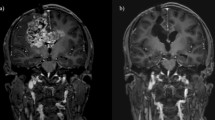Abstract
Diffuse intrinsic pontine glioma (DIPG) is an aggressive infiltrative glioma for which no curative therapy is available. Radiation therapy (RT) is the only potentially effective intervention in delaying tumor progression, but only transiently. At progression, re-irradiation is gaining popularity as an effective palliative therapy. However, at second progression, exclusive symptomatic treatment is usually offered. Here we report two patients with DIPG at second progression who were treated with a second re-irradiation course with good response. Importantly, treatment was well tolerated with no irradiation associated acute toxicity identified.


Similar content being viewed by others
References
Warren KE (2012) Diffuse intrinsic pontine glioma: poised for progress. Front Oncol. 2:205
Robison NJ, Kieran MW (2014) Diffuse intrinsic pontine glioma: a reassessment. J Neuro-Oncol 119(1):7–15
Fontanilla HP, Pinnix CC, Ketonen LM et al (2012) Palliative reirradiation for progressive diffuse intrinsic pontine glioma. Am J Clin Oncol 35(1):51–57
Massimino M, Biassoni V, Miceli R, Schiavello E 2014 Results of nimotuzumab and vinorelbine, radiation and re-irradiation for diffuse pontine glioma in childhood. J Neuroncol 305–12
Porkholm M, Valanne L, Lönnqvist T et al (2014) Radiation therapy and concurrent topotecan followed by maintenance triple anti-angiogenic therapy with thalidomide, etoposide, and celecoxib for pediatric diffuse intrinsic pontine glioma. Pediatr Blood Cancer 61(9):1603–1609
Buczkowicz P, Hawkins C (2015) Pathology, molecular genetics, and epigenetics of diffuse intrinsic pontine glioma. Front Oncol 5:147
Puget BS, Blauwblomme T, Grill J (2012) Is biopsy safe in children with newly diagnosed diffuse intrinsic pontine glioma? Am Soc Clin Oncol Educ Book 629–33
Puget S, Beccaria K, Blauwblomme T et al (2015) Biopsy in a series of 130 pediatric diffuse intrinsic Pontine gliomas. Childs Nerv Syst 31(10):1773–1780
Buczkowicz P, Hoeman C, Rakopoulos P et al (2014) Genomic analysis of diffuse intrinsic pontine gliomas identifies three molecular subgroups and recurrent activating ACVR1 mutations. Nat Genet Nature Publishing Group 46(5):451–456
Fontebasso AM, Papillon-Cavanagh S et al (2014) Recurrent somatic mutations in ACVR1 in pediatric midline high-grade astrocytoma. Nat Genet 46(5):462–466
Khuong-Quang DA, Buczkowicz P, Rakopoulos P et al (2012) K27M mutation in histone H3.3 defines clinically and biologically distinct subgroups of pediatric diffuse intrinsic pontine gliomas. Acta Neuropathol 124(3):439–447
Taylor KR, Mackay A, Truffaux N, Butterfield YS, Morozova O, Philippe C et al (2014) Recurrent activating ACVR1 mutations in diffuse intrinsic pontine glioma. Nat Genet 46(5):457–461
Grasso CS, Tang Y, Truffaux N et al (2015) Functionally defined therapeutic targets in diffuse intrinsic pontine glioma. Nat Med 21(7):827
Morales La Madrid A, Kieran MW, Hashizume R (2015) Future clinical trials in DIPG: bringing epigenetics to the clinic. Front Oncol 5:148
Zaghloul MS, Eldebawy E, Ahmed S et al (2014) Hypofractionated conformal radiotherapy for pediatric diffuse intrinsic pontine glioma (DIPG): a randomized controlled trial. Radiother Oncol 111(1):35–40
Negretti L, Bouchireb K, Levy-Piedbois C, et al. Hypofractionated radiotherapy in the treatment of diffuse intrinsic pontine glioma in children: a single institution's experience. J Neuro-Oncol. 2011 ; 104(3):773–777.
Janssens GO, Jansen MH, Lauwers SJ et al (2013) Hypofractionation vs conventional radiation therapy for newly diagnosed diffuse intrinsic pontine glioma: a matched-cohort analysis. Int J Radiat Oncol Biol Phys 85(2):315–320
Wolff JE, Rytting ME, Vats TS et al (2012) Treatment of recurrent diffuse intrinsic pontine glioma: the MD Anderson Cancer Center experience. J Neuro-Oncol 106(2):391–397
Jackson S, Patay Z, Howarth R et al (2013) Clinico-radiologic characteristics of long-term survivors of diffuse intrinsic pontine glioma. J Neuro-Oncol 114(3):339–344
Author information
Authors and Affiliations
Corresponding author
Ethics declarations
Conflicts of interest
The authors declare no conflicts of interest.
Rights and permissions
About this article
Cite this article
Morales La Madrid, A., Santa-María, V., Cruz Martinez, O. et al. Second re-irradiation for DIPG progression, re-considering “old strategies” with new approaches. Childs Nerv Syst 33, 849–852 (2017). https://doi.org/10.1007/s00381-017-3352-y
Received:
Accepted:
Published:
Issue Date:
DOI: https://doi.org/10.1007/s00381-017-3352-y




